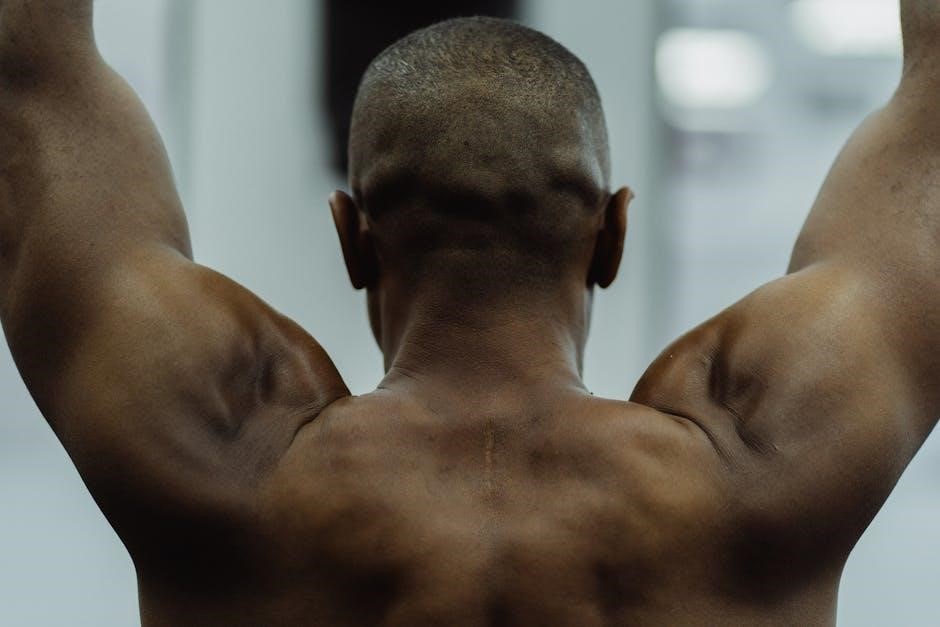Back and bicep workouts are essential for building a strong, balanced upper body. They target key muscle groups, enhancing both strength and aesthetics. With structured PDF guides available, you can follow organized routines designed to maximize muscle growth and definition, ensuring progressive overload and consistent improvement over time.
1.1 Importance of Training Back and Biceps
Training the back and biceps is crucial for building a strong, balanced upper body. These muscles are essential for posture, stability, and overall functional strength. A well-developed back enhances your physique, while strong biceps improve grip and lifting abilities. Neglecting these areas can lead to muscle imbalances and poor athletic performance.
In addition to aesthetics, back and bicep workouts boost everyday functionality, from carrying groceries to participating in sports. They also prevent injuries by strengthening the muscles around the shoulders and arms. Incorporating these exercises into your routine ensures a holistic approach to fitness, promoting both health and physical performance.
1.2 Benefits of Combined Back and Bicep Workouts
Combined back and bicep workouts offer numerous benefits, including enhanced muscle growth and improved training efficiency. By targeting these muscle groups together, you save time while promoting balanced development. This approach also strengthens functional movements, improving grip and pulling power. Additionally, it enhances posture and reduces injury risk by stabilizing the upper body. PDF guides provide structured routines, ensuring progressive overload and consistent gains. This combination is ideal for individuals seeking a well-rounded physique and improved overall strength.
1.3 Overview of Workout PDFs Available Online
Workout PDFs for back and bicep routines provide comprehensive, structured plans to help users achieve their fitness goals. These guides often include detailed exercise lists, sets, reps, and nutritional advice. Many PDFs offer customizable templates, allowing users to tailor workouts to their fitness levels. Programs range from 8-week strength-building plans to 10-week muscle-gain strategies, ensuring variety for different goals. Some PDFs also include step-by-step exercise demonstrations, making them ideal for both beginners and advanced lifters. These resources are widely available online, offering a convenient way to organize and track progress effectively.
Understanding the Muscle Groups
Back muscles include the latissimus dorsi, trapezius, and rhomboids, while biceps consist of the biceps brachii. Understanding their anatomy ensures targeted and effective workouts, maximizing growth and strength.
2.1 Anatomy of the Back Muscles

The back is composed of multiple muscle groups, including the latissimus dorsi, trapezius, rhomboids, and erector spinae. The latissimus dorsi, the largest back muscle, spans the upper body and aids in pulling movements. The trapezius supports shoulder movement and posture, while the rhomboids stabilize the scapula. The erector spinae muscles run along the spine, enabling extension and rotation. Understanding these muscles’ roles and functions is crucial for targeting them effectively during workouts, ensuring balanced development and strength. Proper engagement of these muscles enhances exercise efficiency and reduces injury risk, making anatomical knowledge vital for effective training.
2.2 Anatomy of the Bicep Muscles
The bicep muscles, primarily the biceps brachii, consist of two heads (long and short) originating from the scapula. These heads converge into a single tendon, attaching to the radius bone in the forearm. The biceps brachii is a two-joint muscle, facilitating both elbow flexion and forearm supination. Additionally, the brachialis and brachioradialis muscles assist in elbow flexion, with the brachialis being the primary flexor. Understanding the bicep anatomy helps in targeting these muscles effectively during workouts, ensuring balanced growth and strength. Proper engagement of these muscles enhances exercise efficiency and reduces injury risk, making anatomical knowledge vital for effective training.
2.3 How Back and Biceps Work Together
The back and bicep muscles function synergistically in many exercises. During pull-ups, rows, and curls, the latissimus dorsi and rhomboids in the back work alongside the biceps to pull and stabilize weights. This coordinated effort enhances overall upper body strength and muscle development. Training these muscle groups together improves functional movement and athletic performance. Understanding their interplay allows for more effective workout routines, ensuring both aesthetics and functionality. This integration is a cornerstone of efficient strength training programs, making combined back and bicep workouts highly beneficial for achieving a balanced physique.

Workout Structure and Planning
A well-structured back and bicep workout plan ensures balanced development. Routines like 4-day splits or 8-week programs offer clarity, guiding frequency, duration, and equipment needed for optimal results;
3.1 Split Routines for Back and Biceps
Split routines for back and biceps workouts are designed to maximize efficiency and muscle growth. Common splits include 4-day or 5-day routines, focusing on compound movements like pull-ups, rows, and curls. PDF guides often recommend dedicating one day to back exercises and another to biceps, ensuring adequate recovery time. These structured plans allow for progressive overload, helping to build strength and size over time. By organizing workouts into specific days, individuals can target each muscle group effectively, promoting balanced development and preventing overtraining. This approach is ideal for intermediate lifters seeking consistent progress.
3.2 Frequency and Duration of Workouts
For effective back and bicep development, workouts should be performed 2-3 times per week, allowing 48 hours of recovery between sessions. Sessions typically last 45-60 minutes, focusing on compound exercises like pull-ups, rows, and curls. PDF guides often recommend starting with 3 sets of 8-12 reps for strength and hypertrophy. Increasing frequency or duration should be gradual to avoid overtraining. Warm-up routines and rest periods are crucial for maximizing results and preventing injury. Consistency and progressive overload are key to achieving long-term muscle growth and strength gains in these muscle groups.
3.3 Equipment Needed for the Workout
Effective back and bicep workouts require essential equipment to target muscle groups efficiently. A barbell or dumbbells are crucial for exercises like rows and curls. A pull-up bar is ideal for pull-ups and lat pulldowns, while cable machines are great for isolated movements. Resistance bands can serve as a portable alternative for curls and rows. A weight bench is useful for incline or decline exercises. For advanced lifters, specialized equipment like EZ-bars or rope attachments can enhance workouts. Having access to these tools ensures a well-rounded and progressive training routine, catering to both home and gym environments.

Key Exercises for Back and Biceps
Essential exercises include pull-ups, lat pulldowns, barbell rows, dumbbell curls, and deadlifts. These target the latissimus dorsi, rhomboids, and biceps, ensuring comprehensive muscle development and strength gains.
4.1 Pull-Ups and Lat Pulldowns
Pull-ups and lat pulldowns are foundational exercises for building a strong back. Pull-ups target the latissimus dorsi, rhomboids, and biceps, while lat pulldowns isolate the lats. These exercises are essential for achieving a wide, V-shaped back. To maximize effectiveness, focus on full range of motion and controlled movements. For pull-ups, start with an overhand grip and pull until your chest nearly touches the bar. For lat pulldowns, use a shoulder-width grip and pull the bar to your chest, squeezing your lats at the top. Incorporate variations like wide-grip or neutral-grip pull-ups to target different muscle fibers. Progress by adding weight or resistance bands to increase intensity.
4.2 Barbell and Dumbbell Rows
Barbell and dumbbell rows are versatile exercises that target the back, shoulders, and biceps. Barbell rows allow for heavier loads, engaging the entire back and promoting strength gains. Dumbbell rows offer better range of motion and reduce strain on the lower back. For barbell rows, hinge at the hips, grip the bar shoulder-width, and pull toward your chest. For dumbbell rows, bend at the knees, keep one knee on a bench, and pull the weight to your side. Both exercises improve posture, enhance muscle balance, and are essential for a well-rounded back workout. Include variations like wide-grip or deficit rows to target different muscle fibers.
4.3 Bicep Curls and Hammer Curls

Bicep curls and hammer curls are fundamental exercises for building strong, defined biceps. Bicep curls involve curling a barbell or dumbbells with an underhand grip, targeting the biceps brachii. Hammer curls use a neutral grip, engaging both the biceps and brachialis muscles for a more balanced development. Both exercises require strict form to avoid injury and maximize results. Keep your core tight, elbows close to your body, and focus on controlled movements. Incorporate variations like preacher curls or concentration curls to target different areas of the biceps. These exercises are essential for a comprehensive back and bicep workout routine.
4.4 Deadlifts and Their Variations
Deadlifts are a cornerstone of back and bicep workouts, engaging multiple muscle groups simultaneously. This compound exercise targets the latissimus dorsi, rhomboids, and biceps, while also involving the legs and core. Variations like the conventional deadlift, sumo deadlift, and deficit deadlift allow for targeted emphasis on different muscles. Proper form is crucial to avoid injury, with a focus on maintaining a neutral spine and engaging the core. Start with a weight that allows for good technique and progressively increase the load. Incorporating deadlift variations ensures comprehensive back and bicep development, making them a must-have in any workout routine.
4.5 Cable Rows and Face Pulls
Cable rows and face pulls are versatile exercises that target the back and bicep muscles, promoting balanced development. Cable rows focus on the latissimus dorsi, rhomboids, and biceps, while face pulls emphasize the rear delts and upper back. Both exercises can be adjusted for resistance, making them suitable for all fitness levels. Proper form is key: keep your core engaged, pull smoothly, and avoid jerky movements. Incorporating these exercises into your routine enhances posture, strengthens upper body muscles, and complements compound lifts like pull-ups and deadlifts. Aim for 3-4 sets of 12-15 reps for optimal results.

Workout Routine Examples
Discover structured back and bicep workout routines in downloadable PDFs, offering detailed plans for strength and muscle growth. Examples include 4-day splits, 8-week programs, and 10-week plans tailored to progressive overload and balanced development. These routines provide clear exercise lists, sets, reps, and progression strategies, ensuring consistent improvement and targeted muscle engagement. Perfect for intermediate lifters, they combine compound movements with isolation exercises for a comprehensive approach to building a strong, defined upper body.
5.1 4-Day Split Routine
The 4-Day Split Routine is a popular and effective way to target back and biceps while allowing adequate recovery time. This structured plan typically includes two days of back-focused workouts and two days dedicated to biceps, ensuring balanced development. Key exercises like pull-ups, lat pulldowns, barbell rows, and dumbbell curls are central to the routine. Each workout includes 3-4 sets of 8-12 reps, promoting muscle growth and strength. The program is ideal for intermediate lifters, offering a clear progression path and downloadable PDF guides for easy tracking. This split routine maximizes efficiency and results, helping you build a strong, defined upper body.
5.2 8-Week Back and Biceps Program
The 8-Week Back and Biceps Program is a comprehensive plan designed to build strength and muscle mass progressively. Each week focuses on increasing intensity through heavier weights and higher reps, ensuring continuous growth. The program includes compound exercises like deadlifts and pull-ups, along with isolation movements such as bicep curls and hammer curls. A downloadable PDF guide provides detailed workout schedules, sets, reps, and nutritional advice. This structured approach helps individuals stay motivated and track their progress effectively, leading to significant improvements in both back and bicep development over the course of two months. Consistency and proper form are emphasized throughout the program.
5.3 10-Week Muscle-Building Plan
The 10-Week Muscle-Building Plan is an intensive program designed to maximize back and bicep growth. Each week focuses on targeting these muscle groups with a mix of compound and isolation exercises. The program includes variations like deadlifts, bent-over rows, and cable curls, with a focus on progressive overload. A downloadable PDF guide provides a structured schedule, ensuring each workout builds on the previous one. Nutritional advice and recovery tips are also included to support muscle growth. This plan is ideal for intermediate lifters looking to achieve significant gains in strength and size over a 10-week period. Consistency and dedication are key to achieving optimal results.
5.4 3-Week Fat Loss and Muscle Gain Program
The 3-Week Fat Loss and Muscle Gain Program combines high-intensity back and bicep workouts with a calorie-controlled diet. This program focuses on supersets and circuit training to maximize fat burning while maintaining muscle mass. Each workout includes compound exercises like pull-ups and barbell rows, paired with isolation moves such as bicep curls. A downloadable PDF guide outlines the daily structure, including sets, reps, and nutritional advice. This program is ideal for those seeking rapid results, blending strength training with fat loss strategies to achieve a lean, defined physique in just three weeks. Consistency and proper nutrition are crucial for success.

Progression and Variation
Progression involves increasing weight or reps weekly, while variation includes changing grips or stances to target different muscle fibers. Supersets and drop sets add intensity, ensuring continuous growth.
6.1 Increasing Weight and Reps
Increase weight gradually to avoid plateaus and injury. Aim for small increments weekly, ensuring proper form. Reps can be adjusted based on goals—lower reps for strength, higher for endurance. This approach keeps workouts challenging and promotes muscle growth. Consistency is key to seeing results over time.
6.2 Changing Grips and Stances
Changing grips and stances can target different muscle fibers, enhancing workout effectiveness. For pull-ups, try overhand, underhand, or neutral grips to vary lat and bicep engagement. In barbell rows, a shoulder-width grip focuses on lats, while a wider grip emphasizes rear delts. For curls, experiment with EZ bars or hammer grips to shift emphasis from biceps to brachialis. Stances, like sumo or conventional in deadlifts, alter muscle recruitment. Adjusting these variables keeps workouts engaging and prevents plateaus, ensuring continuous progress in strength and hypertrophy. Regularly modifying grips and stances refreshes routines and challenges muscles differently.
6.3 Incorporating Supersets and Drop Sets
Incorporating supersets and drop sets into your back and bicep workouts boosts intensity and efficiency. Supersets involve performing two exercises back-to-back without rest, such as pairing pull-ups with bicep curls. This method increases time under tension and enhances muscle endurance. Drop sets, where you reduce weight and continue the exercise to failure, maximize muscle fatigue and promote hypertrophy; For example, after completing barbell rows, drop to lighter dumbbells and finish with high reps. These techniques not only save time but also add variety to routines, ensuring consistent progress and preventing plateaus. They’re powerful tools for advancing strength and muscle growth effectively.
Nutrition and Recovery
Nutrition and recovery are crucial for muscle growth and optimal workout performance. Focus on a protein-rich diet, balanced with complex carbs and healthy fats to fuel recovery. Supplements like protein powder and BCAAs can enhance results. Adequate sleep and rest are essential for muscle repair and growth, ensuring you’re ready for your next back and bicep session.
7.1 Diet for Muscle Growth and Recovery
A well-structured diet is vital for muscle growth and recovery during back and bicep workouts. Focus on consuming high-quality protein sources like chicken, fish, eggs, and lean meats to repair and build muscle tissue. Incorporate complex carbohydrates such as whole grains, fruits, and vegetables to provide energy for intense workouts. Healthy fats, including avocados and nuts, support overall health and hormone production. Aim to eat 5-6 meals per day, spaced out every 2-3 hours, to maintain a positive nitrogen balance. Stay hydrated by drinking plenty of water, and consider supplements like whey protein or BCAAs to enhance recovery. Proper nutrition ensures optimal progress and faster recovery.
7.2 Importance of Protein Intake
Protein intake is crucial for muscle repair, growth, and recovery, especially when focusing on back and bicep workouts. Adequate protein helps rebuild muscle fibers damaged during training, promoting strength and hypertrophy. Aim for 1.2-2.2 grams of protein per kilogram of body weight daily, spread across meals. High-quality sources include lean meats, fish, eggs, dairy, and plant-based options like legumes. Protein shakes can supplement whole-food intake, ensuring muscle recovery and growth. Prioritizing protein intake supports muscle synthesis, helping you achieve the desired results from your workouts efficiently.
7.3 Role of Supplements in Workouts
Supplements play a supportive role in enhancing workout performance and recovery. Protein powders, creatine, and BCAAs are popular choices to boost muscle growth and endurance. Whey protein aids in post-workout recovery, while creatine increases strength and stamina. BCAAs help reduce muscle soreness and fatigue during intense training sessions. These supplements complement a well-balanced diet, ensuring adequate nutrition for muscle repair and growth. However, they should not replace whole foods but rather enhance your existing regimen. Consulting a nutritionist can help tailor supplements to your specific back and bicep workout goals, optimizing results and overall performance.

Additional Tips and Tricks
Stay consistent, track progress, and adjust routines as needed. Focus on maintaining proper form to prevent injuries. Incorporate variety in exercises and use recovery techniques like stretching or foam rolling to enhance muscle growth and overall performance.
8.1 Maintaining Proper Form
Maintaining proper form during back and bicep workouts is crucial for maximizing results and preventing injuries. Common mistakes include rounding the back during deadlifts or using excessive momentum for curls. Ensure core engagement and controlled movements. Keep your back straight in rows and avoid swinging weights. Use mirrors or a trainer for feedback. Focus on squeezing target muscles at the peak of each exercise. For curls, keep elbows close to the body and avoid shrugging shoulders. Proper form enhances muscle activation and reduces strain on joints, leading to safer and more effective workouts. Start with lighter weights to master technique before increasing load.
8.2 Warm-Up and Cool-Down Routines
A proper warm-up and cool-down are vital for optimizing back and bicep workouts. Begin with 5-10 minutes of dynamic stretching, such as arm circles and torso twists, to increase blood flow and flexibility. Light cardio, like jumping rope or rowing, can also prepare muscles for exertion. After training, cool down with static stretches for the lats, rhomboids, and biceps to improve recovery and reduce muscle soreness. Incorporate foam rolling to release tension and promote circulation. A well-structured warm-up enhances performance, while a thorough cool-down supports recovery, ensuring long-term progress and injury prevention. Consistency in these routines is key for sustained success.
8.3 Mind-Muscle Connection and Tension
Establishing a strong mind-muscle connection is crucial for effective back and bicep workouts. This connection ensures that you actively engage the target muscles, maximizing growth and strength. Focus on controlled movements, avoiding momentum, and maintain tension throughout exercises. For back exercises like pull-ups and rows, concentrate on squeezing your lats and rhomboids. During bicep curls, keep your core tight and isolate the biceps to prevent swinging. Proper form and intentional engagement enhance workout efficiency, prevent injury, and promote balanced development. Prioritizing this connection leads to better results and a more productive training session, as outlined in many PDF guides available online.

Printable Workout PDFs
Downloadable PDFs offer structured back and bicep workout plans, including 8-week routines, customizable templates, and step-by-step exercise guides, helping you stay organized and motivated during training.
9.1 Downloadable 8-Week Routine
The downloadable 8-week back and bicep workout routine provides a comprehensive plan to build strength and size. It includes detailed exercise schedules, sets, reps, and progression tips. Each week focuses on specific muscle groups, ensuring balanced development. The PDF format allows easy access and tracking, making it ideal for structured training. With clear instructions and visual guides, this routine helps users stay motivated and accountable throughout their fitness journey, ensuring consistent progress and noticeable results by the end of the program.
9.2 Customizable Workout Templates
Customizable workout templates offer flexibility for users to tailor their back and bicep routines to individual goals and preferences. These templates provide a framework with adjustable sets, reps, and exercises, allowing users to modify the plan based on their fitness level. Whether focusing on strength, size, or endurance, the templates cater to diverse needs. They often include space for tracking progress, setting goals, and noting dietary advice. This feature ensures a personalized approach, making workouts more effective and engaging. Users can easily adapt the templates to suit their schedule and available equipment, enhancing consistency and motivation throughout their fitness journey.
9.3 Step-by-Step Exercise Guides

Step-by-step exercise guides provide detailed instructions for performing back and bicep workouts correctly. They often include photos, videos, and written descriptions to ensure proper form and safety. These guides break down each exercise into manageable parts, making it easier for users to follow along and master the movements. Many guides also include tips on warm-ups, cool-downs, and nutritional advice to support recovery. By following these guides, individuals can maintain consistency and progress in their workouts, ensuring they target the right muscles effectively. This resource is particularly helpful for those new to strength training or looking to refine their technique.
Consistency and patience are key to achieving strong, defined back and biceps. With proper planning and dedication, downloadable PDF guides can help you stay organized and motivated, ensuring long-term success in your fitness journey.
10.1 Summary of Key Points
10.2 Final Tips for Consistency and Success
Consistency is key to achieving results in back and bicep workouts; Set clear goals and track progress using a workout log or app. Stick to your routine, gradually increasing weight or reps to avoid plateaus. Focus on proper form to prevent injuries and maximize muscle engagement. Prioritize nutrition, ensuring adequate protein intake to support muscle growth. Stay hydrated and get enough rest for recovery. Celebrate small victories to stay motivated, and embrace the journey of building strength and definition. With dedication and patience, you’ll achieve a stronger, more defined upper body over time.